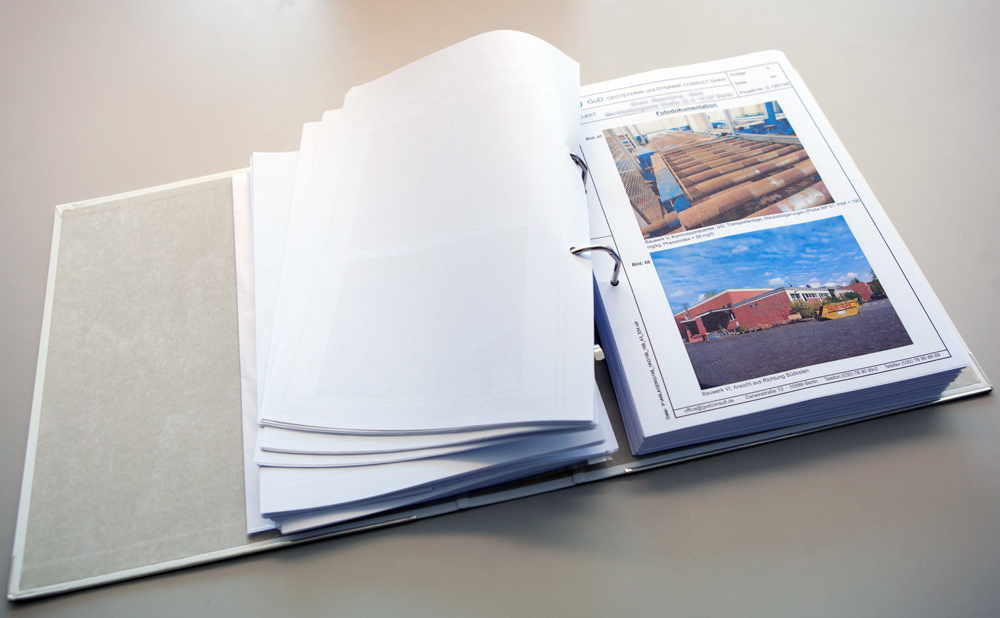Deconstruction
There are many factors to consider when deconstructing a building (including adjacent construction, its use in the area, subsequent use of the land, pollution). In collaboration between our experts from the areas of structural engineering, vibration insulation as well as environmental protection, GuD is able to plan and supervise deconstruction projects, taking into account all boundary conditions in a technically and economically optimised way.
The disposal of demolition waste and hazardous waste materials is always a cost-driving factor for all deconstruction projects. The decisive factor will probably be the extent of hazardous materials that are common in all buildings built before the year 2000. These dangerous substances can either enter the building structure through use (e.g. oils), or be an actual part of the building materials (e.g. asbestos). The amounts and costs can be reduced to a minimum and the necessary methods for work and immision protection can only be determined through early detection as part of the planning process, and by separation during construction.
Waste and disposal management

Any construction project will generate waste material that have to be disposed of properly. The appropriate soil, waste and disposal management approach ensures that most contaminated waste material is already separated during excavation or demolition and that suitable as well as economical ways of disposing of them have been lined up; provided that there is no recovery path possible on the construction site itself. Greater efficiency can be achieved through the early involvement of experts, which will contribute to the optimisation of disposal costs as well. Since the introduction of the electronic verification directive (German eNAV), GuD owns readers and cards as well as the appropriately trained experts who are still working on numerous projects. GuD primarily uses the ZEDAL method.
Concepts and coordination for safety plans
The correct handling of hazardous material is particularly important where humans and the environment have to be protected from such exposures. Industrial safety in technical and organisational areas must be a priority; deployment of personnel in the contaminated area should be kept to a minimum. GuD has released occupational safety and immission protection concepts as well as working and safety plans for actions that could involve harmful or hazardous substances. We also have experienced staff that can take on the duties of an occupation safety coordinator i.a.w. DGUV Rule 101-004.
Planning the building pollution remediation, construction site clean-up and deconstruction methods
Important prerequisites for a reliable tender are the thorough assessment of all harmful and hazardous substances in a pollution cadastre and a deconstruction plan tailored to the object. This will also facilitate the technically as well as economically optimised implementation taking into account the interests of occupational safety and pollution control agencies.

The range of GuD planning services includes the complete clearing of construction sites as well as decontamination or the deconstruction of individual buildings, on to complete industrial complexes, sometimes even crane-assisted deconstruction. The necessary planning depth depends on the complexity of the methods used, as well as the overlap with other planning units involved. The projects can range from a relatively simple concept on to rather involved planning, including structural analysis for deconstruction and recommendations for vibration protection in the area. The next step is to send out requests for tenders for these steps with detailed descriptions as well as service item texts and bill of quantities requirements. This is followed by the evaluation of tenders and, if necessary, professional assistance in defining the terms of contract.
Pollutant cadastre

Before a demolition / deconstruction project begins the harmful and potentially hazardous substances in the building components are captured visually and also analytically if necessary, followed by listing and evaluating them in a pollutant cadastre. At that point the classical workup of the hazardous waste issue is often amended with a solid waste engineering report of the entire construction site’s mineral structure. A pollutant cadastre includes the registration of the Finding and Sample taking points, an evaluation in terms of the potential danger of hazardous materials encountered, including a reference to the labour protection and the corresponding statutory regulations (e.g. German Technical Rules for Hazardous Substances (TRGS) TRGS 519, TRGS 521, TRGS 524 or German Society for Mandatory Accident Insurance DGUV Rule 101-004). It will also address all disposal issues with classifications on the basis of the Working Group of the German Federal States on Waste (Länderarbeitsgemeinschaft Abfall (LAGA)) and specifying preliminary waste key numbers according to the European Waste Catalogue - EWC. Quantity surveys, the creation of a room book as well as the estimation of demolition and disposal costs are among the possible further options in our range of planning services.
Monitoring construction site clearing, removal of hazardous substances in buildings and deconstruction actions
The execution of a construction site clean-up, hazardous substance removal from buildings and deconstructions processes can be supervised by one of our associates experienced in the field. This includes all services provided for construction site supervision, plus disposal management and the processing of all legally required electronic verification procedures for hazardous waste materials. Depending on the scope of the project and the extent of the pollutant inventory the accompanying GuD representative will be temporary or permanent. Inspections will take place for compliance with the requirements of the labour protection act according to the German Society for Mandatory Accident Insurance (DGUV) Rule 101-004, soil protection according to the Federal Soil Protection Act - German BBodSchG, as well as immission protection according to the Federal Air Pollution Act BImSchG. Vibration protection for buildings and equipment in the area by will be estimated by GuD as needed, planning and implementation upon request.